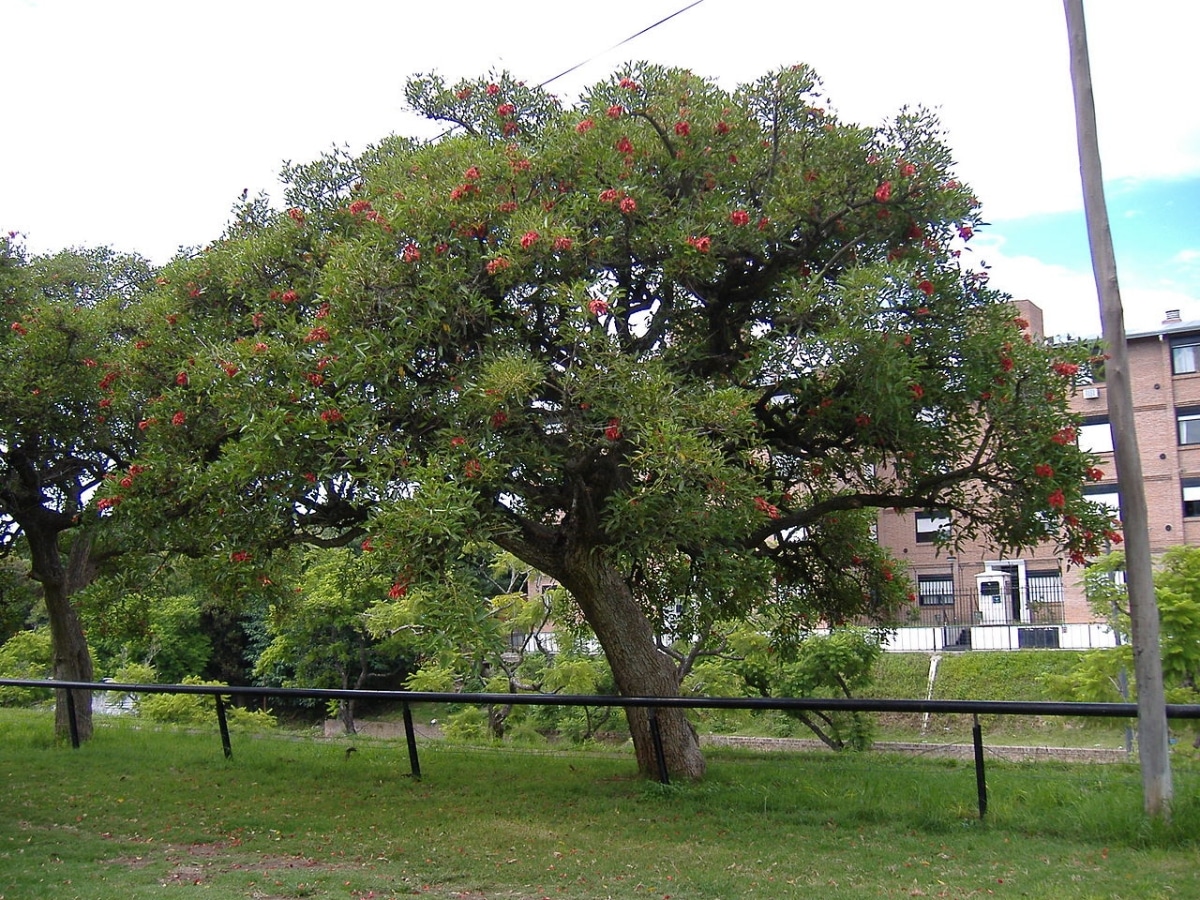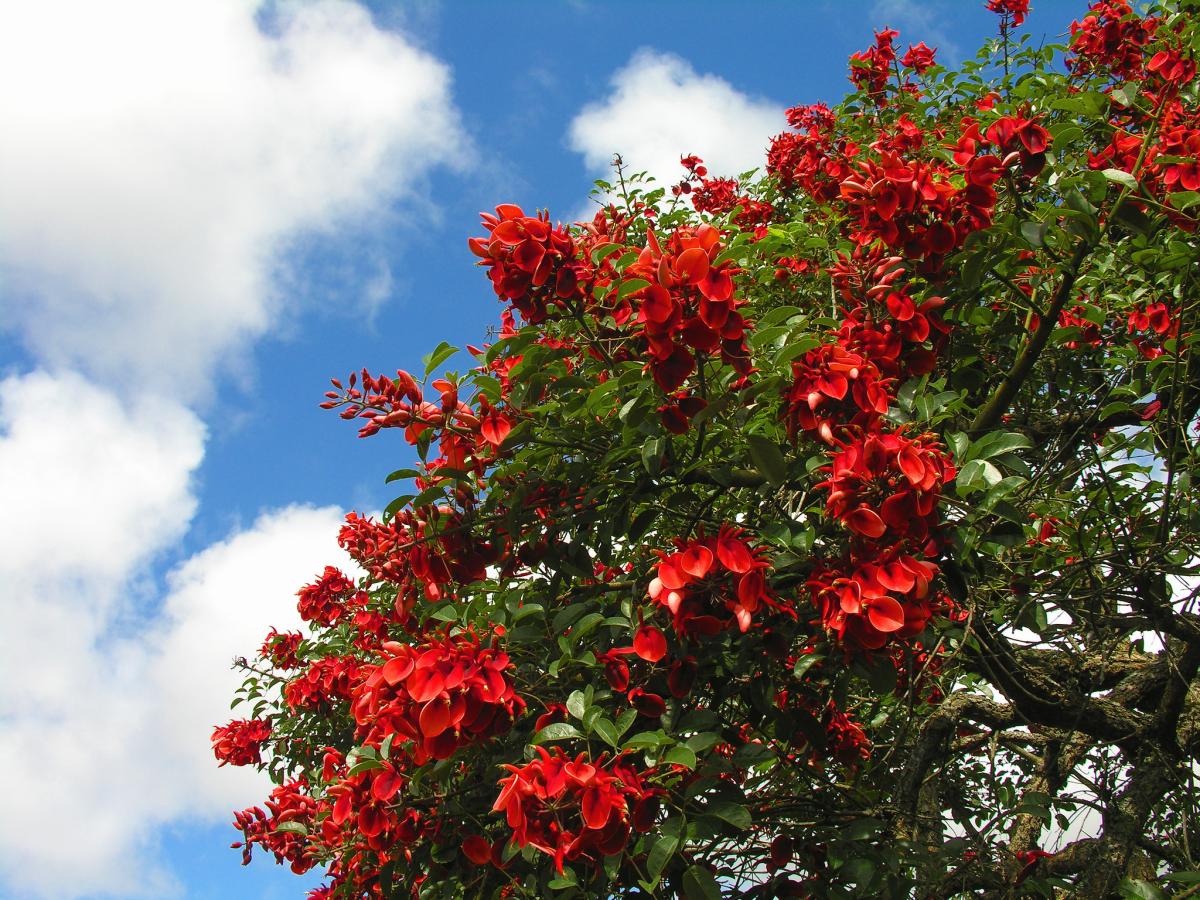
If you want to design a tropical garden but there are frosts in your area, it is important that you look for species that are capable of withstanding them, since otherwise you would spend money and time in vain. Therefore, this time I recommend the tree Erythrina crista-galli, much better known by the names of ceibo or rooster's crest.
It withstands the cold very well, and light frosts down to -4ºC do not harm it; in fact, it is a good candidate for cultivation in much of the Mediterranean region, as well as in any area with a subtropical climate.
Origin and characteristics of ceibo

Image - Wikimedia / Pablo-flores
The cockscomb is a deciduous tree native to South America, where it grows in Brazil, Argentina, Paraguay, Uruguay and Bolivia, whose scientific name is Erythrina crista-galli. It usually grows up to 8 meters high, but if the climate is mild all year round and it lacks nothing, it can reach 20 meters.. The trunk is tortuous, and its roots fix nitrogen to the soil thanks to the symbiosis they establish with nitrifying bacteria. The leaves are composed of 3 oblong-lanceolate laminae or leaflets that have a leathery texture. These turn brown in the fall before falling off.
Blooms in spring, and it does so by producing coral-red flowers grouped in a cluster. Once pollinated, the fruit matures into a short legume about 10 centimeters long, which contains several dark brown/black seeds.
What is?
It is a tree that can benefit us in several different ways:
- it is ornate: Its flowers are its main attraction, but really, even without them, it is a very decorative plant, which can be kept as an isolated specimen, or in rows. Also, it provides shade.
- Fix nitrogen (N) to the soil: Nitrogen is one of the most important nutrients for plants, as it helps them grow. If you plant a ceibo tree in the ground, you would expect that soil to end up with more N than it did before.
- It is melliferous: In other words, thanks to its flowers, you will be able to obtain honey.
- attract the birds: with it you can have a more alive garden.
How do you take care of the rooster comb?
The ceibo is a tree that can help us to have that tropical garden that we love so much without the need to provide it with too much care. But so that problems do not arise in the future, we recommend taking into account what we are going to tell you next:
Climate
We have said that it is capable of withstanding the cold and even some frost, and it is so, but the truth is that we cannot forget either the thermal amplitude; that is, the difference between the maximum and minimum temperature.
And it is that it is not going to recover as quickly from winter in a place where in that season the minimum temperature remains at 0º with occasional frosts, and the maximum is 5ºC; than in another where the minimum is 0º but the maximum is 18ºC or higher. The milder the temperatures, the better it will do.
If we add the wind to that, we have to know that the stronger it blows and/or if it blows frequently, the later it will resume its growth.
Location

Image – Flickr/Eduardo Amorim
La Erythrina crista-galli or kapok has to be outside as long as the weather permits. Moreover, we will only have to protect it in some way -in a greenhouse or indoors- if the frosts are moderate or intense.
In the event that the wind blows a lot but the temperatures are mild, it is best to think about planting a windbreak hedge or plants that serve as such, or if it is still in a pot, to put it in an area where it is a little more protected .
Soil or substrate
The cockscomb is a tree that can grow on almost any type of soil, but we advise that it be planted in a rich one, and that it drains the water well. In addition, if it is going to be grown in a pot -something that can only be done for a few years, until it measures 2 meters in height at most- you must use a quality universal substrate such as this.
Irrigation
The most advisable thing is to let the soil have time to dry out a bit before watering it again, since the roots of the ceibo do not resist waterlogging. Because, it will be watered an average of 3-4 times per week during the summer; the rest of the year it will be done less frequently, as temperatures are cooler and the soil stays moist longer.
Subscriber
It is convenient to pay it, especially if you are young, several times throughout the year with bat guano, manure, or compost for example. This will ensure that it grows with health and strength.
Multiplication

Image - Wikimedia / Forest & Kim Starr
the kapok multiplies by seeds in spring, which can be sown in seed trays or in pots with specific soil, such as this. Another way is by cuttings, also during that season.
Rusticity
The tree resists up to -4ºC without being damaged.
Do you dare to grow a ceibo in your garden?